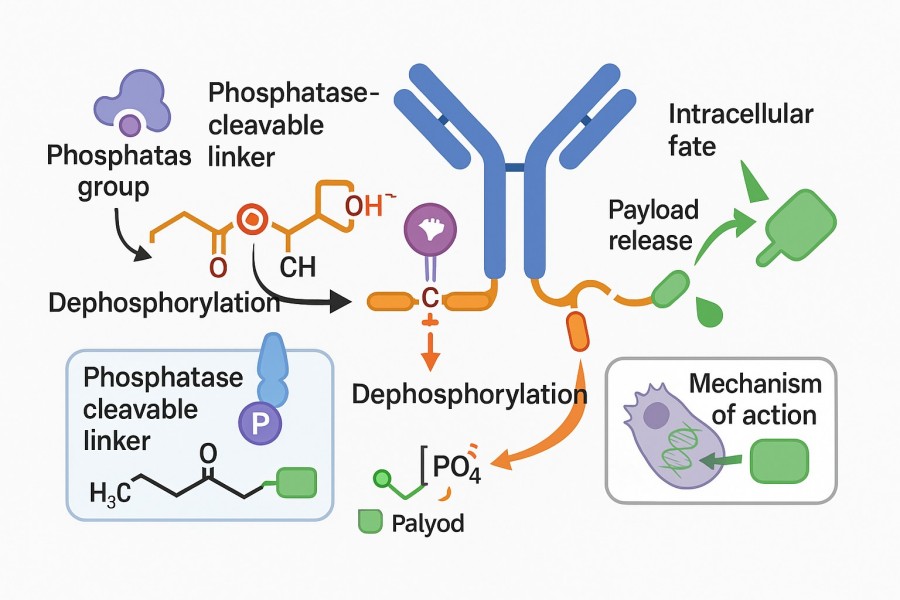Phosphatase cleavable linker is an enzyme-responsive linker based on a phosphate ester structure, capable of achieving efficient drug release in tumors or specific microenvironments with high phosphatase expression. Combining stability with selectivity, it is widely applied in antibody-drug conjugates (ADCs) and prodrug design. BOC Sciences has accumulated extensive experience in this field, offering one-stop services from custom linker design, structural optimization, and quality testing to scale-up production. Leveraging advanced synthesis platforms, strict quality control systems, and a professional technical team, BOC Sciences provides ADC linker solutions that meet international standards, supporting drug development and precision medicine.
Phosphatase cleavable linker is a cleavable linker designed based on a phosphate ester bond or related chemical structures. Its core principle is to utilize phosphatase catalysis in vivo or within the tumor microenvironment to induce hydrolysis or structural changes in the linker, thereby cleaving it to release the drug molecule. Phosphatase cleavable linkers represent another important class of enzymatic linkers, selectively targeting enzymes within lysosomal compartments. These linkers target pyrophosphatases and acid phosphatases, hydrolyzing pyrophosphate and terminal monophosphate groups into corresponding alcohols. Kern et al. reported a phospho-bridged protease B-sensitive linker for delivering glucocorticoids to tumor cells. Since then, phosphatase cleavable linker systems, using fatty alcohol conjugation, have been increasingly applied for ADC payload delivery. Furthermore, in vitro studies of ADCs containing this linker show high plasma stability, rapid lysosomal cleavage, and water solubility.
 Fig. 1. Phosphatase cleavable linker in ADCs (BOC Sciences Authorized).
Fig. 1. Phosphatase cleavable linker in ADCs (BOC Sciences Authorized).
Similar to tissue proteases, pyrophosphatases and phosphatases are hydrolytic enzymes selectively expressed in lysosomes. Phosphatases have attracted attention in drug research due to their crucial roles in cell signaling and activity regulation. Pyrophosphate linkers are water-soluble, which facilitates aqueous bioconjugation with antibodies and reduces ADC aggregation risk. While these features support the use of such linkers for bioconjugation and ADCs with lipophilic payloads, in vivo validation is still pending. In 2016, researchers designed linkers containing phosphate and pyrophosphate groups and coupled them with the mature, protease B-sensitive Val-Cit-PABA structure for glucocorticoid delivery. The phosphate/pyrophosphate motif was integrated between a self-immolative PABA spacer and the payload. Upon internalization, the payload can be released through sequences involving protease B, the self-immolative spacer, and phosphatase. Researchers also developed a unique pyrophosphatase-based linker applied in anti-CD70 ADCs to release hydroxyl-containing payloads dexamethasone and fluticasone propionate. Both ADCs showed good 7-day stability in mouse and human plasma and exhibited strong activity against CD70 cell lines.
In the field of phosphatase cleavable linkers, we have accumulated rich R&D and industrialization experience, offering clients comprehensive services from concept design and custom synthesis to structural optimization, analytical validation, and scale-up production. Our goal is to help clients achieve more efficient and precise drug delivery in drug development, ensuring sufficient linker stability in circulation while enabling efficient drug release within target cells via phosphatase action.
BOC Sciences not only provides standardized linker development services but also offers tailor-made linker solutions optimized for different payloads (cytotoxins) and antibodies. Leveraging our extensive experience in chemical synthesis, molecular modification, and conjugation strategies, clients gain more precise and efficient ADC construction tools, accelerating the progression of drugs from research to clinical application.
Tailored phosphatase cleavable linker structures are designed according to specific research goals and project requirements, achieving the optimal balance between stability and release efficiency.
Covering the complete workflow from early-stage R&D and structural optimization to pilot-scale and industrial production, saving time and cost while accelerating the translation of ADCs from the laboratory to clinical use.
All linker products comply with strict international quality systems, ensuring purity, stability, and batch-to-batch consistency, meeting high standards for research, clinical, and commercial applications.
A multidisciplinary team of experts in synthetic chemistry, biochemistry, and drug engineering provides scientifically sound and innovative technical solutions based on extensive experience.
Equipped with GMP-standard production workshops and quality control systems, ensuring product safety, compliance, and traceability in line with international regulatory requirements.
Optimized synthesis and production processes significantly shorten R&D and delivery timelines, enabling clients to efficiently advance projects and quickly enter subsequent stages of research or application.

Gain a deep understanding of clients' research goals, project background, and linker application needs to ensure service solutions closely align with actual R&D directions.
Develop a scientifically sound phosphatase cleavable linker design plan based on client requirements and molecular characteristics, balancing stability and release efficiency.
Perform custom synthesis under advanced laboratory conditions using efficient chemical reaction routes to ensure accurate and reliable linker structures.
Utilize multi-dimensional analytical techniques, including HPLC, MS, and NMR, to comprehensively verify linker purity, structure, and functional properties.
Deliver samples that meet requirements on schedule, accompanied by complete analysis and validation reports to support clients' subsequent R&D and regulatory submission efforts.

Provide long-term technical support and optimization advice, assisting clients in resolving potential issues during ADC development or industrialization.
The mechanism of phosphatase cleavable linkers is based on enzymatic cleavage triggered by phosphatases. These linkers remain stable in circulation but are selectively hydrolyzed when exposed to elevated phosphatase activity in the target microenvironment. This ensures controlled drug release within tumor cells or diseased tissues, improving therapeutic precision and reducing systemic toxicity in antibody-drug conjugates (ADCs).
The primary function of phosphatase cleavable linkers is to connect the antibody and payload while enabling site-specific drug release. They maintain stability in the bloodstream but undergo enzymatic cleavage at the target site, ensuring the payload is released only where needed. This dual role enhances the safety, efficacy, and pharmacokinetics of ADC-based therapies.
Testing a phosphatase linker involves evaluating its stability and cleavage efficiency using analytical methods such as HPLC, LC-MS, and NMR. In vitro enzyme assays are conducted to confirm sensitivity to phosphatase activity, while cell-based models validate selective drug release. These tests ensure the linker meets the required stability and functional criteria for ADC development.
The function of a phosphatase linker in drug delivery is to act as a trigger-responsive bridge between the carrier and drug molecule. It ensures drugs remain inactive during systemic circulation but are activated upon phosphatase cleavage in diseased tissues. This selective activation improves therapeutic outcomes by enhancing targeted delivery and reducing off-target toxicity.
We have production capabilities ranging from milligram-scale R&D samples to gram and even kilogram-scale batches. Leveraging GMP-compliant facilities and a rigorous quality control system, BOC Sciences provides linker products required for both research and industrial applications, ensuring batch-to-batch consistency and stability.
Clients can submit their requirements through our online platform or via email. Our team will evaluate the needs, develop a personalized design and synthesis plan, and initiate the project upon signing a collaboration agreement. We deliver the product along with a comprehensive analytical report and provide ongoing support for clients' subsequent research.
Background
A biopharmaceutical R&D organization based in Boston, USA, was developing an ADC drug, "ADC-Tox1," targeting advanced solid tumors, with a microtubule inhibitor as its payload. Due to high phosphatase activity within tumor cells, the research team aimed to use a phosphatase cleavable linker for targeted payload release while maintaining high stability in circulation. The project faced multiple challenges, including complex linker design, cleavage rate control, and conjugation efficiency optimization.
How BOC Sciences Helped?
BOC Sciences provided end-to-end custom services:
Implementation Process
Key Results
In the publications section of BOC Sciences, you can view research articles published by global clients using our products and services, showcasing the application value and scientific impact of our technologies in cutting-edge drug development.

"Working on a challenging ADC project, we needed a phosphatase cleavable linker with precise enzymatic release. BOC Sciences provided a tailored solution with excellent purity and full analytical reports. Their expertise made our preclinical studies much smoother."
— Dr. Michael Thompson, Senior Scientist (USA)
"BOC Sciences assisted us in designing a phosphatase cleavable linker compatible with a sensitive payload. Their professional team guided us through synthesis, characterization, and optimization. Delivery was fast and results exceeded expectations."
— Prof. Emma Jensen, Research Director (Denmark)
"We required a custom phosphatase cleavable linker for an antibody conjugation study. BOC Sciences delivered high-quality material and thorough documentation, supporting our in vitro and in vivo evaluations. Highly recommended for precision ADC work."
— Dr. David Martin, Principal Investigator (UK)
"Facing complex linker design challenges, BOC Sciences provided both scientific guidance and rapid synthesis for our phosphatase cleavable linker project. Their consistent quality and responsive support greatly accelerated our development timeline."
— Dr. Sophie Müller, Lead Research Scientist (Germany)
From cytotoxin synthesis to linker design, discover our specialized services that complement your ADC projects.
Find exactly what your project needs from our expanded range of ADCs, offering flexible options to fit your timelines and goals.
Contact our experts today for pricing and comprehensive details on our ADC offerings.










